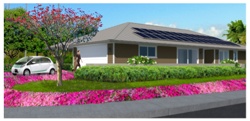KONAUS™ HOUSE
Specifications Executive Summary
- Four-sided design variable steel roof at 20° (HI) or 30° (CA) angle from horizontal to maximize solar panel efficiency.
- Open, airy sunbelt design, factory manufacturable
- Optional rainwater catchment system with hidden cistern (dependant on climate area)
- Excellent Insulation, including doors and windows – “Smart” efficient heating and cooling.
- 4-6 kW on-grid net-metered PV system (80+% replacement)
a. Assumes propane or gas availability for cooking, water heating, heating, clothes drying, or passive solar hot water heating - 6-8 kW on-grid PV system (95%-100% replacement, all electric home)
- 6-10 kW off-grid PV system (100% replacement with storage backup)
- CFL and LED lighting throughout house (no incandescent)
- Energy Star rated efficient appliances specified throughout
- Electric Vehicle-ready garage – true zero CO2 automobile emissions.
- Efficient, renewable building and finishing materials (e.g., bamboo flooring option)
- Advanced split septic system if city sewer not available
a. Ultra low-flush toilets, controlled flow showers, etc. - “Smarthouse” pre-wired with single-pull CAT 5e or 6, cable, phone and alarm system, and a remotely accessible KONAUS House website
Marketing Concepts
- Acquire Energy Star qualification and high NatHERS house rating
- LEEDs Efficiency compliant
- Energy Star rated appliances specified throughout
- HUD, FHA, EPA Certifications
- Pre-approve financial incentives from utilities, governments
- Pre-appraisal from major home lenders
- Major builder design differentiation for tract homes
- Innovative PV energy system financing option
- Robust national US PR campaign (initially HI, CA and US sunbelt)
- KONAUS™ House non-provisional patent application filed with the USPTO
PV Financing Concept
The photo-voltaic solar electric system of the KONAUS house will be constructed at no initial cost to the homeowner. The system will be funded by an “energy environmental loan” using the house as collateral. All environmental government and utility financial incentives offered for the solar electric system will be applied to reduce the principle of this loan. The homeowner will be obligated to “purchase” his electricity from his own PV system at a rate equal to 90% of the utility electric rate the time of closing. (This rate will not escalate over time, even though the local utility rate undoubtedly will.) The money from the homeowner’s (and any successor homeowner’s) electric “purchase” will be used to pay off the solar electric system construction loan. It is expected that the loan will be retired between six years and fifteen years, depending on the system size, base local electric utility rate and other factors. After the loan is retired, the PV solar electric system will be totally owned by the homeowner.
